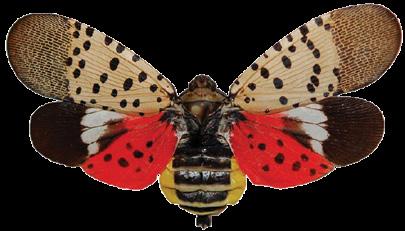
4 minute read
Blue Ridge Explorers with Tamara S. Randolph
BLUE RIDGE EXPLORERS
Blue Ridge Explorers


Spotted Lanternfly adult and nymphs | Photo by Stephen Ausmus-USDA-ARS
Be On the Lookout
By Tamara S. Randolph
Sometimes exploring leads you to discoveries you’d rather not find. Such is the case with non-native invasive plants and animals—unwanted organisms from afar that have found their way into our landscape, usually with help from humans. These “invaders” compete with native organisms for habitat and food, and can wreak havoc on natural ecosystems and agricultural zones.
Take, for instance, the Burmese python, an enormous snake native to parts of Asia that is now widespread in south Florida. It has disrupted the ecological balance in swamplands and continues to pose big problems for wildlife and humans. On the plant side, consider kudzu—once thought to be a beneficial import, this non-native invasive can grow nearly a foot per day, covering and smothering everything in its path.
Not all non-natives are bad. Many have “naturalized” in their new home, and some non-natives are even beneficial. One of the best examples is the European honeybee. Non-native plants and animals only become “invasive” when they aggressively outcompete native species and begin to damage their new environs.
BAD BUG ALERT
Alien insects can be especially destructive. Good examples of “bad bugs” here in N.C. are the hemlock woolly adelgid, which has laid waste to much of the eastern hemlock forests, and the emerald ash borer, a beetle that can destroy ash trees. However, with early action and cooperation, we can identify and locate a “bad bug” and stop it from becoming a runaway pest. Right now a number of scientists, agencies and organizations here in NC are working hard to ward off one very bad bug, the spotted
lanternfly (SLF).
Spotted lanternfly, Lycorma delicatula, is an invasive planthopper that was first detected in the U.S. in 2014. It likely made landfall in Pennsylvania as a “hitchhiker” on imported stone tile products. SLF is native to parts of Asia, and its spread to other countries has become problematic in recent decades. Here in the U.S., the pest has been detected in over 12 of our states, including four detections (all dead adults) in NC. The bit of good news is that live populations of spotted lanternfly have not been found in North Carolina...yet.
That said, the time has come to be vigilant. “It is a matter of when it arrives as opposed to if it arrives,” says Whitney Swink, an entomologist with the North Carolina Department of Agriculture & Consumer Services. “We want to get as many people educated as possible so that we can hopefully tackle it and do ‘spot eradications’ when it does show up.”
Spotted lanternfly is a piercing-sucking insect that produces copius amounts of honeydew while feeding. “In addition to reducing home values because of black sooty mold growth, and the honeydew dropping on people, is the sheer amount of sugar water that is basically attracting a ton of stinging insects, and so people unfortunately are being stung by ants and wasps.” SLFs also do harm to many of the beneficial plants they feed on.
“One of the really key characteristics of spotted lanternfly and why it is such a problem is because it has a VERY broad host range,” explains Swink. She says that they are known to feed on more than 70 species of woody plants, including grapes, stone fruits, apples, maple, oak, walnut, willow, and the SLF’s favorite plant, tree of heaven, a highly aggressive non-native tree that is already well established in NC.
“The spotted lanternfly, despite having this broad host range, seems to LOVE tree of heaven. It is its favorite food in the world,” says Swink. She adds that one of the characteristics of tree of heaven is that it is an allelopathic plant. “Basically it produces chemicals that will kill off other plants around it; it is incredibly prolific. So when you realize it’s a favorite food for spotted lanternfly and their favorite food is all over the state, you realize how quickly this can get out of control.”
SEE IT, SNAP IT, REPORT IT
Spotted lanternfly overwinters in the egg stage, hatching into nymphs during late-Spring to early-Summer. There are four nymphal (instar) stages prior to becoming adults in late summer. The 4th nymphal stage (late instar) and adults are fairly easy to identify (see photos above) and are active this time of year.
This is where you, as a citizen scientist, can help. Early detection will be critical in stopping the spread of SLF and minimizing the devastating effects it could have on landscapes, communities, businesses and agricultural crops, particularly grapevines, fruit trees, and a wide range of hard-










